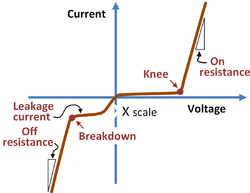User:John R. Brews/Draft
A semiconductor diode is a two-terminal device that conducts current in only one direction, made by joining a p-type semiconducting layer to an n-type semiconducting layer.
Electrical behavior
The ideal diode has zero resistance for the forward bias polarity, and infinite resistance (conducts zero current) for the reverse voltage polarity. The pn-diode is not ideal. As shown in the figure, the diode does not conduct appreciably until a nonzero knee voltage is reached. Above this voltage the slope of the current-voltage curve is not infinite, but exhibits a nonzero forward resistance. In the reverse direction the diode conducts a nonzero leakage current (exaggerated by a smaller scale in the figure) and at a sufficiently large reverse voltage below the breakdown voltage the current increases very rapidly with more negative reverse voltages.
